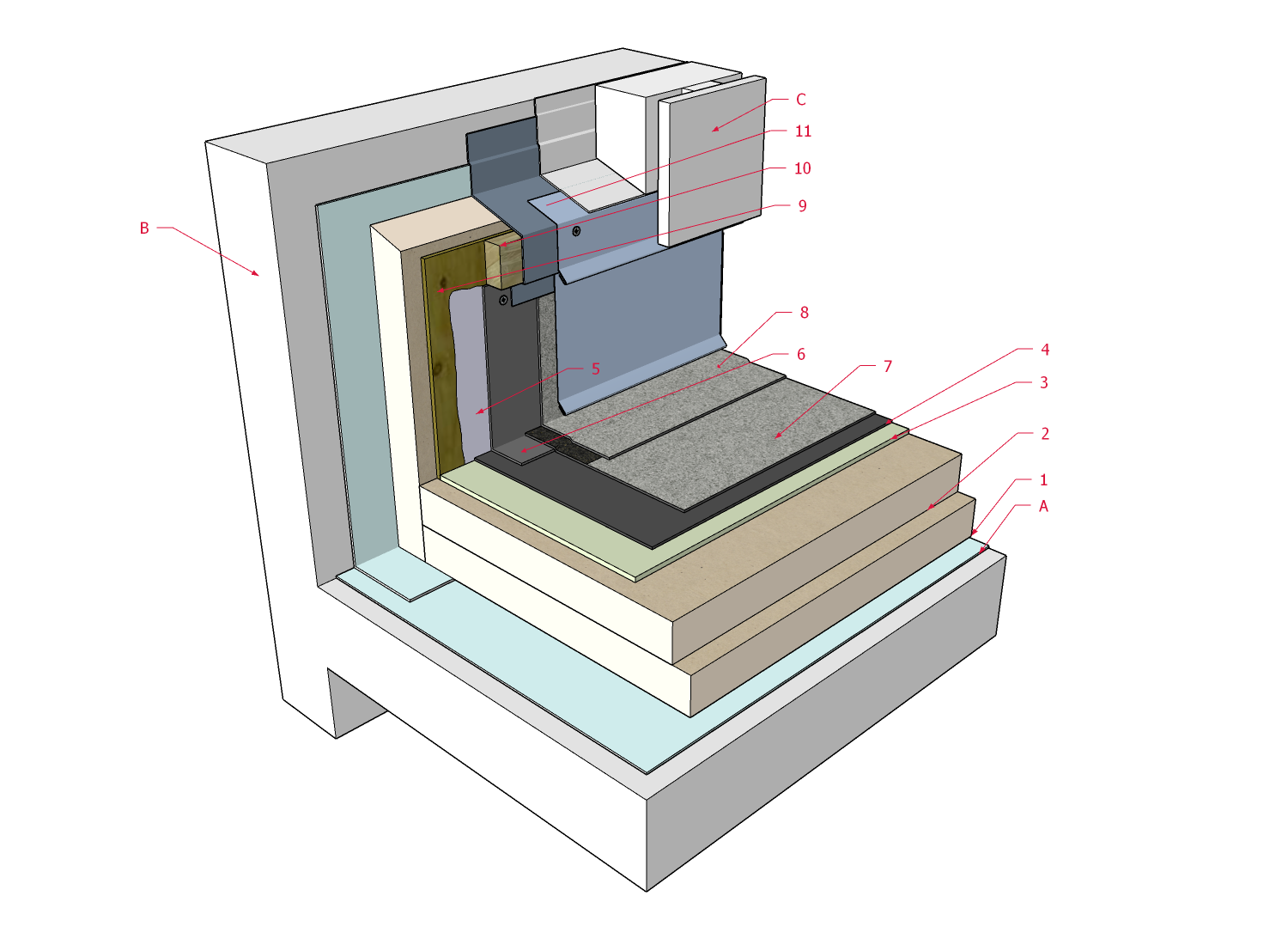Draft CD 13
Draft CD 13
Revision as of 16:09, 16 February 2024 by James Klassen (talk | contribs)
Division D - Construction Details
SBS | Membrane Termination A (Wall) ( Article 10.3.2.3.)
| Notice to Reader | |
| Images used in a Construction Detail are representative and not prescriptive, and are not necessarily drawn to scale. They are intended to support the related Standard (Ref. Division A, Article 2.2.1.2.).
The reader may link to the related Article in the detail title, or link to the Standard as it relates to a specific element in the detail. All hyperlinks are displayed blue text. | |
SBS Details
1 WORK INCLUDED
- (1) Air/Vapour Control Layers
- As specified by the Design Authority and installed to provide continuity for optimal control.
- (2) Insulation
- Installed in keeping with Section 7.3. Multiple layering illustrated; layers must be offset and staggered at least 304.8 mm (12”) in each direction.
- (3) Insulation Overlay Panel
- Required for fully adhered membrane systems or when overburden is specified. Panels must be offset and staggered from underlying insulation panels.
- (4) Base Sheet Field Membrane
- See Table 9.2. for permissible application methods and corresponding membrane properties. Membrane must be installed according to the requirements in Section 9.3.
- (5) Primer or Adhesive
- Proprietary to the membrane manufacturer. Primer may be required for self-adhered membranes. All membranes applied to the vertical substrate must be fully adhered.
- (6) Base Sheet Flashing Membrane
- Install in keeping with the requirements in Section 10.3. Base sheet membrane flashing must extend onto the roof field at least 101.6 mm (4"). Membrane shall be carried up the vertical substrate at least 203.2 mm (8”) above the finished roof system surface, plus at least 76.2 mm (3”) for wall control layer overlap. In regions where heavy snow accumulation is possible, or to accommodate future roof membrane replacement, membrane should be carried at least 304.8 mm (12”) up the vertical substrate.
- (7) Cap Sheet Field Membrane
- See Table 9.2. for permissible application methods and corresponding membrane properties. Membrane must be installed according to the requirements in Section 9.3.
- (8) Cap Sheet Flashing Membrane
- Install in keeping with the requirements in Section 10.3. Cap sheet membrane flashing must extend onto the field at least 152.4 mm (6"), or at least 50.8 mm (2”) past the edge of the base membrane flashing.
- (9) Rigid Support for Through-wall Flashing (optional)
- Where the wall is insulated on the exterior side of the structure, continuity of air and vapour controls must be protected from future damage during roof replacement. This can be done by securing a suitable membrane receiver panel against the insulation. The panel must be permanently affixed to the structure through the insulation. During replacement of the roof membrane, membrane flashing may be removed from the receiver panel without disturbing the insulation and control layers. In this way, material waste is also reduced.
- Where the membrane may not easily separate from its receiver during roof replacement, a second panel (not illustrated) can be screw-fastened to the first. During replacement, both the membrane and the secondary panel may be removed together, simplifying membrane replacement.
- (10) Membrane Flashing Substrate
- Continuity of the water-resistive barrier means it must pass through the insulation assembly installed on the exterior side of the wall structure. To do that, a membrane flashing passes through the insulation where the roof system terminates. Blocking or another suitable support (i.e., hat track) is necessary to support the membrane and its linear metal flashing carrier. Wood blocking illustrated.
- (10) Through-wall Flashing
- A self-adhered membrane is used to transition from the wall to the roofing assembly, providing a continuous drainage path for water. Secure the linear metal flashing to the support underneath (see Item 9 or 10 above).
- Note that the water resistive barrier membrane from the wall (installed by others – see Related Work below) overlaps the through-wall flashing (installed by the Contractor) and is supported by a metal flashing with drip edge, to direct water from the wall to the roof surface.
2 RELATED WORK BY OTHERS
- (A) Acceptable Deck
- Illustrated deck is representative. See Sub-section 2.1.5. for acceptable deck types and conditions.
- (B) Wall Structure
- Illustrated wall is representative. Wall control layers (i.e., water resistive barrier) must overlap roofing system to achieve continuity. See Sub-section 2.1.7. for wall conditions.
- (C) Wall System Finish
- Illustrated system is representative and shows water-resistive barrier overlapping roof membrane (See above, Item 8).
NOTE: See the SBS Roof Systems Standard for additional requirements.
Back to SBS Roof System Details
© RCABC 2024
RoofStarTM is a registered Trademark of the RCABC.
No reproduction of this material, in whole or in part, is lawful without the expressed permission of the RCABC Guarantee Corp.

